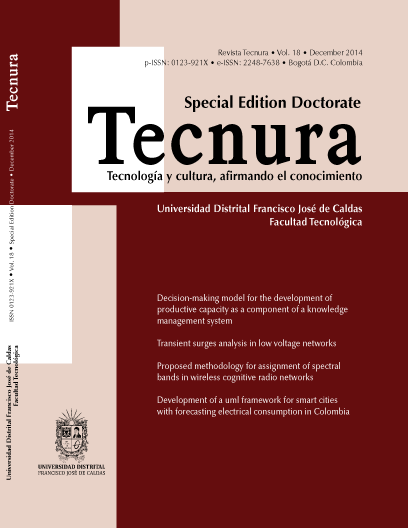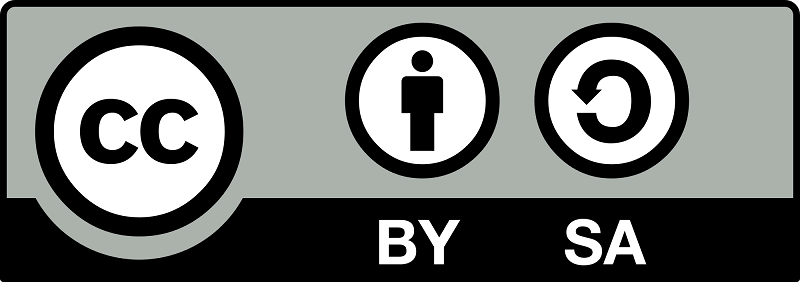DOI:
https://doi.org/10.14483/22487638.9251Publicado:
01-12-2014Número:
Vol. 18 (2014): Special Edition DoctorateSección:
ReflexiónSoftware engineering as a vehicle for water resources environmental planning
La ingeniería de software como vehículo para la planificación ambiental de los recursos hídricos
Palabras clave:
Software engineering, environmental planning, municipal wastewater treatment plants, life cycle analysis (en).Palabras clave:
Software engineering, environmental planning, municipal wastewater treatment plants, life cycle analysis (es).Descargas
Resumen (en)
Software engineering is an important discipline of knowledge that allows abstracting an environmental system, modeling a watershed and providing conceptual and interaction elements of players in the configuration of modeling approaches for decision-making on water resources environmental planning; therefore, the purpose of this article is to have anenvironment envelopethrough a set of environmental aspects that can be represented by a meta-model that leads to a cognitive constructof the problemand defines the methodological model for proper environmental planning of watersheds, in decision-making at strategic and operational levels.
Resumen (es)
La ingeniería del software es una importante disciplina de conocimiento que permite abstraer un sistema ambiental, modelar una cuenca y proporcionar elementos conceptuales y de interacción de los jugadores en la configuración de enfoques de modelado para la toma de decisiones sobre planificación ambiental de los recursos hídricos; por lo tanto, el propósito de este artículo es tener una envolvente ambiental a través de un conjunto de aspectos ambientales que puedan representarse mediante un metamodelo que conduzca a una construcción cognitiva del problema y definir el modelo metodológico para la planificación ambiental adecuada de las cuencas hidrográficas, en la toma de decisiones en niveles estratégicos y operacionales.
Referencias
Abrahamsson, P. (2002). Agile software development methods review and analysis.VTT Publications.
ACODAL. (2013). Aguas residuales y ciudades. Bogotá: Asociación Colombiana de Ingeniería Sanitaria y Ambiental.
Argent, R. (2001). Land and water resources model integration: software engineering and beyond. Advances in Environmental Research, 351 - 359.
Argent, R. (2004). An overview of model integration for environmental applications components, frameworks and semantics. Environmental Modelling & Software, 219 - 234.
Aronoff, S. (1989). Geographic Information Systems: a management perspective. Ottawa, Canadá: WDL Publications.
Beecham, s. (2008). Motivation in Software Engineering: A systematic literature review. Information and Software Technology, 860 - 878.
Benveniste, G. e. (2011). Análisis del ciclo de vida y reglas de categoria de producto en la construcción. El caso de las baldosa cerámicas. Informes de construccion, 71 - 81.
Bjarnason, E. (2012). Are you biting off more than you can chew? A case study on causes and effects of overscoping in large-scale software engineering. Information and Software Technology, 1107 - 1124.
Bjørnson, F. (2008). Knowledge management in software engineering: A systematic review studied concepts, findings and research methods used. Information and Software Technology, 1055 - 1068.
Bolaños, S. (2010). AIA "AMBIENTE INGENIERIL ARTISTICO". Bogotá.
Bolaños, S. (2012). LMPS como una propuesta alterna a BPMN para el modelado de procesos de software. Tecnura, 157 - 170.
Bolaños, S. (2012). Process management software as a script and the as a pattern. International Journal of Computer and Communication Engineering, 147 - 150.
Bolaños, S. (2012). Software process modeling language spml- as an alternative proposal to bpmn for modeling development processes. Tecnura, 158 - 171.
Bolaños, S. (2014). Software Processes and Methodologies Modeling, Language −SPMML− Holistic Solution for Software Engineerin. IEEE LATIN AMERICA TRANSACTIONS, 818- 824.
Briand, L. (2000). Exploring the relationships between design measures and software quality in object-oriented systems. The Journal of Systems and Software, 245 - 273.
Brilhante, O. (2003). Municipal Environmental Planning and Management Training. The netherlands: IHS.
Castelletti, A. (2010). Visualization-based multi-objective improvement of environmental decision-making using linearization of response surfaces. Environmental Modelling & Software, 1552 - 1564.
Castelliti, A. (2008). Integration, participation and optimal control in water resources planning and management. Applied Mathematics and Computation , 21 - 33.
Chomsky, N. (1957). Syntactic structures. Berlin: Walter de Gruyter Gmbh & Co.
David, O. (2013). A software engineering perspective on environmental modeling framework design: The Object Modeling System. Environmental Modelling & Software, 201 - 213.
Davis, A. (1994). Fifteen principles of software engineering. Software IEEE, 94 - 96.
De Carvalho F, A. (2001). Análisis del ciclo de vida de productos derivados del cemento - aportaciones al análisis de los inventarios del ciclo de vida del cemento. Barcelona, españa: Universidad Politecnica de Cataluña.
Deusto Tech. (2012). Metodología para el análisis del ciclo de vida de depuradoras de aguas residuales.Deusto: Universidad de Deusto .
Dietrich, J. (2010). CHAPTER 11. Workflow Oriented Participatory Decision Support for Integrated River Basin Planning.
Dittrich, Y. (2014). Software engineering beyond the project Sustaining software ecosystems. Information and Software Technology, 1436 - 1456.
Ellison, M. (1998). Business process modelling using activity theory: An approach to data capture and analysis. Australian Computer Journal, 146 - 152.
Flores X., e. a. (2014). Balancing effluent quality, economic cost and greenhouse gas emissions during the evaluation of (plant - wide) control/ operational strategies in WWTPs. Science of the total environmental, 616 - 624.
Florez, H. (2009). Procesos de ingeniería de software. Revista Vinculos, 26 - 39.
García, L. E. (1998). El Manejo integrado de los recursos hídricos en America latina y el Caribe. No ENV - 125. Washington D.C.: Banco Interamericano de Desarrollo BID.
Garrido M. et al. (2013). Including the environmental criteria when selecting a wastewater treatment plant. Environmental modelling & software, 85 - 95.
Germain, E. (2005). Engineering-based processes and agile methodologies for software development: a comparative case study. Journal of Systems and Software,, 17-27.
Hanssen, G. (2012). A longitudinal case study of an emerging software ecosystem: Implications for practice and theory. The Journal of Systems and Software, 1455 - 1466.
Jacobson, I. (2000). El Proceso Unificado de Desarrollo de Software. USA: Addison Wesley.
Kasoju, A. (2013). Analyzing an automotive testing process with evidence-based software. Information and Software Technology, 1237-1259.
Kroll, P. (2006). Agility and Discipline Made Easy: Practices from OpenUP and RUP. Upper Saddle River, NL: Addison Wesley Pub Co Inc.
Leitmann, J. (1999). Sustaining Cities: Environmental Planning and Management in Urban Design. USA.
Leontief, W. (1986). Input - Outpu economics. Second edition. New York: Oxford University Press.
Marín, D. (2012). Informe técnico sobre sistemas de tratamiento de aguas residuales en Colombia - línea base 2010. Bogotá D.C.: Superintendencia de Servicios Públicos Domiciliarios.
Millar, D. (2004). Integrating City Planning And Environmental Improvement: Practicable Strategies For Sustainable Urban Development. London UK.
Misic, M. (2004). Systems analyst activities and skills in the new millennium. Journal of Systems and Software, 31 - 36.
Niazi, M. (2010). Software process improvement barriers: A cross-cultural comparison. Information and Software technology, 1204 - 1216.
Pilone, D. (2005). UML 2.0 in a Nutshell. USA.
Pilskalns, O. (2007). Testing UML designs. Information and Software Technology , 892 - 912.
Pressman, R. (2010). Ingeniería del software. 7 Edición. Mexico: McGraw Hill.
Reed, M. (1999). A framework for modelling multiple resource management issues—an open modelling approach. Environmental Modelling & Software, 503 - 509.
Rizzoli, A. (1997). Delivering environmental decision support systems: software tools and techniques . Environmental Modelling & Software, 237 - 249.
Rizzoli, A. (2008). Developments in Integrated Environmental Assessment. Chapter Seven Integrated Modelling Frameworks for Environmental Assessment and Decision Support. USA: Elsevier Science.
Robles, K. (2012). Towards an ontology-based retrieval of UML Class Diagrams. Information and Software Technology, 72 - 86.
Rodríguez J.P. (2012). Assessment of an aerobic treatment system for. Int. J. Environmental Engineering, 307 - 314.
Rodríguez J.P. et al. (2013). Diseño y evaluación de un sistema de tratamiento de aguas residuales (sedimentador Sedhelcon y reactor biológico aeróbico modificado Flocairrf) en planta piloto. Bogotá: Universidad Distrital.
Rodríguez J.P., e. a. (2010). Estudio de comparación del tratamiento de aguas residuales domésticas utilizando lentajas y buchón de agua en humedales artificiales. Tecnología y ciencias del agua (ingeniería hidráulica en méxico), 59 - 68.
Rodríguez, J. (2010). Contaminación del agua. In Contaminación ambiental en Colombia (pp. 255 - 300). Bogotá: Fundación en causa por el desarrollo humano.
Rosen, K. (2004). Matematica discreta. New York: Mc Graw Hill.
Salah, A. (2006). Use of goal programming and integer programming for water quality management—A case study of Gaza Strip. European Journal of Operational Research, 1991 - 1998.
Sheila, S. (2004). Earthly Politics: Local and Global in Environmental Governance (Politics, Science, and the Environment).USA.
Sommerville, I. (2005). Ingeniería de Software. Madrid, España: Pearson Education S.A.
Tabares, L. (2011). Personalización de RUP para proyectos académicos de desarrollo de software.Medellin, Colombia: EAFIT.
Willard, B. (2007). UML for systems engineering. Computer Standards & Interfaces, 69 - 81.
Zhang Q.H. et al. (2010). Application of life cycle assessment for an evaluation of wastewater treatment and reuse project - case study of Xi An, China. Bioresource technology, 1421 - 1425.
Cómo citar
APA
ACM
ACS
ABNT
Chicago
Harvard
IEEE
MLA
Turabian
Vancouver
Descargar cita
Licencia
Esta licencia permite a otros remezclar, adaptar y desarrollar su trabajo incluso con fines comerciales, siempre que le den crédito y concedan licencias para sus nuevas creaciones bajo los mismos términos. Esta licencia a menudo se compara con las licencias de software libre y de código abierto “copyleft”. Todos los trabajos nuevos basados en el tuyo tendrán la misma licencia, por lo que cualquier derivado también permitirá el uso comercial. Esta es la licencia utilizada por Wikipedia y se recomienda para materiales que se beneficiarían al incorporar contenido de Wikipedia y proyectos con licencias similares.


